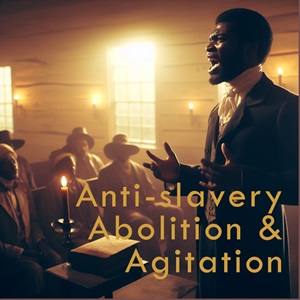

Study Areas
The African American Burial Ground Near Fort Hunter
Susquehanna Township, Dauphin County, Pennsylvania
The photographs below were taken by a hiker who stumbled upon the old African American burial ground while hiking in the hilly area behind Fort Hunter. The cemetery is the final resting place for some of the people who were servants at Fort Hunter, including members of the Craig family. Five persons are identified, four of whom are known to be members of the Craig family. One grave is marked but lacks identifying information on the stone, and one grave has a base for a marker, but the marker is missing. It is not known how many persons are buried in this grave yard, and if unmarked graves are present. All photographs on this page are by "Glenn", who kindly submitted them to the Afrolumens Project for publication.
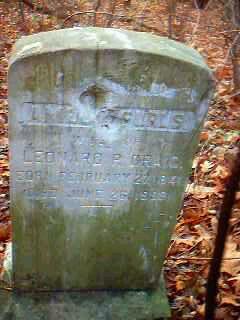 Located
in the second row of graves, in the northeast corner of the lot, this marker reads: "AMELIA SURLES/ wife of / LEONARD P. CRAIG / BORN FEBRUARY 27 1841/ DIED JUNE 26 1899"
Located
in the second row of graves, in the northeast corner of the lot, this marker reads: "AMELIA SURLES/ wife of / LEONARD P. CRAIG / BORN FEBRUARY 27 1841/ DIED JUNE 26 1899"
The researcher who surveyed the cemetery and transcribed the markers for Fort Hunter several years ago noted "shot gun marks" on this marker. those marks are very evident in this photograph.
For a close-up view of this tombstone, click here.

This stone is for Andrew Craig, and is the oldest dated grave on the site. Located in the southwest corner of the lot, it is actually the first grave in the first row. The graves are arranged in two distinct rows, and all face east, in traditional African American burial fashion.
This stone includes an image of a hand with the index finger pointing heavenward, carved in bas relief, a traditional image on grave markers of this period. The carved wording reads: "ANDREW CRAIG/ born July 21 1795/ died Aug. 21 1863/ Aged 68 yrs. 1 mo."
Like the marker shown above for Amelia Surles, this stone bears the scars of a shotgun blast. The marker for Andrew's wife Rachel is at the other end of this row.
Archibald McAllister, the owner of Fort Hunter, registered the child of a slave, named Andrew, as a slave to age 28. This is possibly that person.
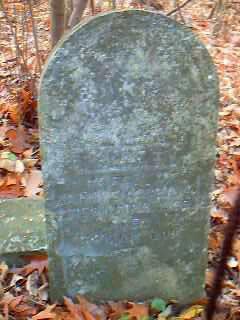
Using the age given above and calculating back from the date of death, Rachel would have been born on June 20, 1814. A footstone for this grave is in the second row, marked simply "R.C." Click
here to view the footstone. Between the markers for Rachel and Andrew Craig stands a small stone for George Washington Pratt, which reads "GEO. WASHINGTON/ Son of/
Boris & Henrietta/ PRATT/ was killed by locomotive/ July 25, 1866/ Aged 8 years 5mo./ 3 days." That stone is not pictured here.
Located at the northern end of the first row, this heavily weathered stone marks
the grave of Rachel Craig, wife of Andrew Craig. It says: "RACHEL/ wife of/ ANDREW CRAIG/ DIED JAN 9, 1889/ AGED 74y. 6m.
20d."

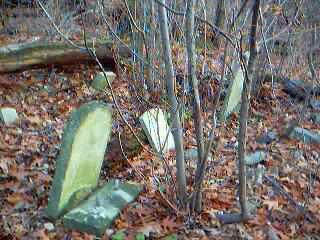
The two views above are facing approximately southeast. Identities for the graves have been superimposed over the first image. In the Fort Hunter transcription, referred to above, the researcher noted a "stone wall one stone high" surrounded the burial ground. That wall is still extant in some places, as seen to the right in the second photograph. Some of the other wall stones can be seen piled in the southeast corner. There is also one other grave visible in the second photograph, nearest to the fallen log at the top center. This is the stone for the child of Leonard P. and Amelia Craig. It reads "ANDREW E./ son of/ LEONARD P. & AMELIA/ CRAIG/ DIED NOV 24 1891/ AGED 12y. 3m. 7d."
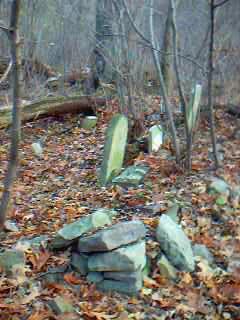
This view gives a good feel for the existing rows of the burial ground, showing the line of graves in the westernmost row. The pile of wall stone is in the foreground.
The Craig family were slaves and servant at Fort Hunter for many years. The earliest record that mentions the family name is the registration by Archibald McAllister of several slave children, Lucy Craig, James Craig and Eliza Creag. He also registered the slave child Andrew (surname not given), whose age matches the person whose grave is pictured above. These were probably all children of Sally Craig, a slave for life, registered in 1780 simply as "Sal."
From later records, we know that Sally's surname is Craig, and that she ran away in 1828 when McAllister advertised to sell her in local newspapers. Sally Craig never returned to Fort Hunter and her fate is unknown. Some of her descendants remained nearby, however, as seen by these graves that date from as late as 1899.
Over the course of his life, Archibald McAllister registered 22 slaves, and may have owned others that we do not know about. Not all of these persons were living at Fort Hunter at one time, however. In the 1790 census, McAllister is recorded as having six slaves living on his estate. In 1800, he had four slaves and six other free persons (term-slaves, held to service until age 28). By 1810 his holdings had decreased to two slaves and nine "free coloured persons," probably a mix of term-slaves and free Blacks. The census considered term-slaves as free Blacks for enumeration purposes and only counted as slaves those persons still being held for life.
In 1820 McAllister was enumerated with two "free coloured males" and three "free coloured females." His son, John, who was helping to run the estate by this time, was enumerated with three "free coloured males" and one "free coloured female." By 1828, when Archibald McAllister advertised to sell Sally Craig, she was the only slave left, and in the 1830 census, Archibald McAllister had no slaves or servants listed under his name. John McAllister was listed with one male slave and two female slaves, as well as three "free coloured males" and one "free coloured female." Archibald McAllister died in 1831. The 1840 census lists John McAllister with only one "free coloured female." By 1850, no African Americans were listed as residents at Fort Hunter.
It is not known how many of these persons buried in this small grave yard were among those who were slaves or servants at Fort Hunter. Andrew Craig is probably an ex-slave from that estate, and some of the others may have been among the nameless "free coloured persons" enumerated by census takers. A connection seems probable, though, because the McAllister family plot is located nearby, and literature available from the Fort Hunter Mansion notes that those Blacks buried in the ground pictured on this page were probably workers from the estate.
The 1880 census of Dauphin County shows Rachel Craig residing in Middle Paxton Township with a daughter, Hannah, who was born about 1846, and Leonard and Amelia Craig and their infant son Andrew, residing in East Hanover Township.
Click here to view the slave holdings of Archibald McAllister of Fort Hunter.
Click here to read the text of the Gradual Emancipation Act of 1780, that required the registration of slaves in Pennsylvania and made distinctions between slaves for life and term slaves.
Click here to go to the official Fort Hunter Web site.
